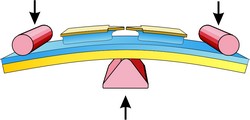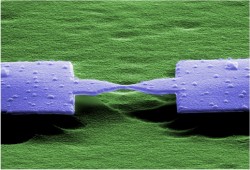
One step towards an understanding of electronic transport on the atomic scale lies in the investigation of single-atom contacts. These can be fabricated, as mentioned above, with the help of STMs or by using suspended nanobridges, which can be thinned down to atomic width by elongation. The elongation is performed by bending the underlying substrate in a three-point mechanism (see Fig. 1), causing the name "mechanically controllable break-junction (MCB)". Fig. 2 shows an electron micrograph of a lithographically defined nanobridge made from aluminum. It is suspended over a length of approximately 2 µm. The single-atom contact in the center of the constriction is not visible at this magnification. The advantage of first studying single atoms lies in the conceptual simplicity of the circuit which allows one to understand its properties in detail.

It has been shown by statistical investigations that single-atom contacts have an element-specific preferred conductance or resistance value, respectively. Typical values are 5 kΩ for niobium, 8 kΩ for lead, 13 kΩ for gold, and 15 kΩ for aluminum. This material dependency does not follow the observations for macroscopic wires explained by Ohm's law based on a size-independent conductivity. Contrary to the observations of the atomic contacts, macroscopic gold wires have a ten times larger conductivity as compared to lead. The conductance of atomic-size contacts is determined by the interplay of the chemical valence and the structure, while in wires scattering events of the electrons with phonons and imperfections dominate the transport properties.
The investigations of single-atom contacts are continued in our group with the emphasis on the behavior of magnetic contacts, contacts made from semi-metals, and high-current, nonlinear, and interference effects. We furthermore use these contacts as electrodes for contacting individual molecules or clusters.
